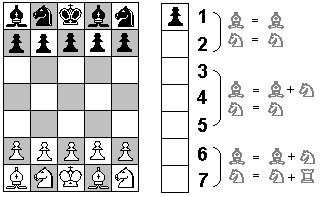Regulator Chess
Samuel H. Bell
Introduction
Regulator Chess is a variant on 42-squares where the actual play occurs on 35 squares, and the other 7 squares compose a track on which a neutral Regulator piece travels up and down. The Regulator's position on the track modifies how some pieces can move on the main board.
Board and Setup
Each side has 1 King, 5 Pawns, 2 Bishops, and 2 Knights. There is also a neutral "Regulator" piece, which is not on the main board, and cannot be moved (directly) by either player.
The board consists of a main 7x5 rectangle, and a separate 7x1 regulator area. The regulator area's spaces are numbered 1 through 7 consecutively.
White's first rank contains, from left to right, Bishop Knight King Bishop Knight. White's second rank contains five pawns. Black's setup is the reverse of White's on the other side of the board. The regulator piece starts on space number 1, unless the players agree to start it on a higher space.

| (black) BNKBN G 1 PPPPP . 2 ..... . 3 ..... . 4 ..... . 5 ppppp . 6 bnkbn . 7 (white) |
Rules
The game is conducted by rules of FIDE Chess, except when noted otherwise below.
- The King moves and captures as in FIDE chess. The object of the game is to checkmate the King.
- Pawns move and capture as in FIDE chess, except they cannot make a double move, and cannot capture en passant.
- Bishops move as in FIDE chess, unless the Regulator piece is at space 3 or higher; in this case, they can also move as a Knight.
- Knights move as in FIDE chess, unless the Regulator piece is at space 6 or higher; in this case, they can also move as a Rook.
- If a pawn reaches the back rank, its owner must promote it to either a Rook, Knight, Bishop, or Queen. Rooks and Queens are the same as in FIDE chess, and their powers do not change based on the Regulator's position.
- Anytime either player makes a Pawn move, the Regulator piece advances one space, unless it is already at 7.
- Anytime either player makes a capture, the Regulator piece retreats one space, unless it is already at 1.
- (Corollary to 6 and 7) If a Pawn makes a capture, the Regulator moves offset and there is no change.
- As in FIDE chess, it is illegal to make a move that exposes the King to attack.
- Stalemated players lose.
- After all ten Pawns have been captured or promoted, Rule 7 no longer applies.
Notes
The regulator area is completely closed-off and separate. No pieces can move into or out of it.
Rule 9 also applies to Pawn moves that give enemy pieces additional powers. For example, if White's King is standing next to Black's Knight, and the Regulator is on 5, White cannot move a Pawn; doing so would push the Regulator to 6, enabling the Knight to capture the King with a Rook-move. White can, however, capture with a Pawn, because this does not affect the Regulator.
It is legal to escape check by making an unrelated capture that disables the power the attacking piece is using to check the King.
Rule 11 is provided as a hedge against insufficient-material draws that can occur if there is much bloodshed late in a game.
Equipment
Regulator Chess can be played with a normal Western Chess set, by marking off the unneeded squares and using a spare Pawn as the regulator.
Computer Play
An implementation of Regulator Chess has been written for Zillions of Games. You can download it here:
Written by Samuel H. Bell. HTML conversion by Peter Aronson.
WWW page created: March 28th, 2002.
